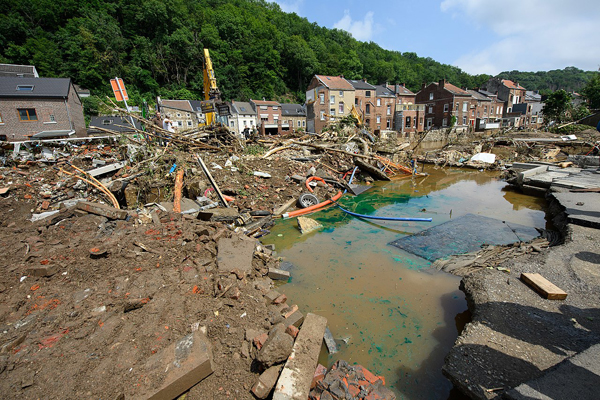Flooding patterns expected to change with future warming
Moderate storms will sometimes produce less runoff, but extreme storms will become more destructive
Sep 1, 2021 - by David Hosansky
Sep 1, 2021 - by David Hosansky
Climate change will significantly alter future patterns of flooding, according to a new study led in part by the National Center for Atmospheric Research (NCAR). Although future increases in moderate storms won’t necessarily lead to more runoff in many regions, extreme storms will generate more devastating and frequent flooding.
The reason that increasing precipitation will have these differing impacts on flooding has to do with the influence of warmer temperatures on both atmosphere and land, the study found. At the same time that warmer temperatures will cause the atmosphere to release more moisture, they will dry out soils and enable the land to absorb more rain and snowmelt.
As a result, the water from moderate cloudbursts can seep into the ground instead of inundating the landscape. But the drenching precipitation from extreme storms, which are becoming more frequent with climate change, will saturate the soil and cause increases in flooding, according to advanced computer simulations by the research team.
“It may seem counterintuitive, but climate change can lead to both reduced flooding for moderate rainfall and increased flooding for extreme rainfall,” said the study’s lead author, Manuela Brunner. “This is especially dangerous if a lack of changes in moderate events gives us a false sense of security when, in fact, extreme flood events will become increasingly likely and potentially cause more extensive damage.”
The threshold for increases in precipitation leading to more flooding varies according to season, elevation, and other factors, the researchers found. The study’s findings could have significant implications for infrastructure design and flood risk mitigation strategies.
Brunner, a visiting scientist at NCAR, conducted her research as an NCAR postdoctoral fellow. She is currently a lecturer at the University of Freiburg. The research team also includes scientists from the University of Munich, the University of California Los Angeles, and the Nature Conservancy.
The study was published last week in Communications Earth and Environment. Funding came from the National Science Foundation, which is NCAR’s sponsor, and other organizations.
Major deluges, such as the torrential rains that caused devastating flooding in western Europe this summer, have heightened concerns about the impacts of a changing climate. But streamflow observations across much of the world have provided mixed evidence regarding the response of flooding to increasingly intense downpours.

To better determine the relationship between precipitation and flooding in a warming world, the research team used a combination of a climate model and a hydrologic model to run a large ensemble of simulations, comparing historical conditions in the late twentieth century with projected warmer conditions at the end of this century. Their approach enabled them to capture both the atmospheric response to climate change and conditions at the surface such as streamflow and soil moisture. It also allowed the scientists to evaluate a significant number of extreme events, such as 100-year floods that are rarely observed in the real world.
The research team applied the modeling to 78 watersheds in Bavaria, but their approach is also applicable for watersheds elsewhere.
The results showed there are thresholds, depending on the catchment, beyond which increases in intense precipitation translate to increases in flooding because precipitation overwhelms the ability of the land to absorb all the moisture. In some cases, the threshold might be a 1-in-10-year event or “return interval”; in other cases, the return interval may be a 1-in-50-year or even more extreme event.
The variations depend in part on season and elevation, as well as the size of river basins.
“Flooding is not just about precipitation. It’s also about snow and soil and other catchment characteristics,” Brunner said. “It’s important to understand that you can’t just apply the same change factor to every kind of flood event.”
The study did not look at urban settings in which paved surfaces are largely impermeable and lead to a relatively direct relationship between increasing precipitation and flooding. But its findings are relevant to regions in the world with temperate climates and hydrological systems that are driven by precipitation or snowmelt.
“Antecedent conditions such as soil moisture are important in modulating moderate events,” Brunner said. “The hydrologic response to precipitation varies, and we need to understand these variations in order to strengthen society's resilience to floods."